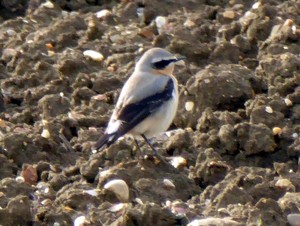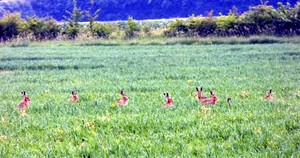Up to 31 species of farmland birds were recorded on NIAB’s farm and trials fields on the outskirts of Cambridge during spring 2017.

Breeding species included ‘red-listed’ Grey Partridge, Yellow Wagtail, Linnet, Yellowhammer and Skylark. The Meadow Pipit was also seen; since 2016 it has become a bird of conservation concern. The Corn Bunting was recorded as a non-breeding species with passage migrants including the Northern Wheatear and a single Turtle Dove, now a critically endangered summer migrant to Europe.
The birds were noted during an annual survey carried out for the Red List Revival, a UK-based charity working to restore disappearing, ‘red-listed’, bird species identified within the Government’s Biodiversity Action Plan. This is the fourth year the survey has been carried out by retired NIAB colleague Bob Jarman over six different dates from April to June. Bob used a combination of formal walked 1km2 transects and informal observations along the farm roads to survey the birdlife.
There were fewer Yellow Wagtails and Meadow Pipits this year, which could be down to changes in the field rotation and headland vegetation becoming too long for nesting. Other arable and hedgerow bird species present on the farm include Reed Buntings, Whitethroat, Willow Warblers, Blackcaps and Chiffchaffs. Whilst raptors such as Buzzards, Kestrels and Sparrowhawks were noted, these tended to be single birds so breeding pairs could not be confirmed. Bob also saw Green Woodpeckers and NIAB staff have reported Coots and Little Grebes raising young on the reservoir and Little Owls and Little Egrets on the farm.

The Red List Revival also notes mammals, reptiles and amphibians, in vertebrates and plants as part of the Survey. Common Lizards have been seen by NIAB staff on the roadbridge across the A14 dual carriageway and Bob was lucky to see nine Brown Hares together on one field. Butterflies included Green-veined White, Large White, Small Skipper, Ringlet,Gatekeeper, Meadow Brown and Common Blue. Chalkland plants en Woodpeckers and NIAB staff have reported Coots and Little Grebes raising young on the reservoir and Little Owls and Little Egrets on the farm. Tufted Vetch and Common Century have become established in one of the conservation headlands, with the farm ditches a spectacular display of Meadow Sweet, Yellow Flag and Water Figwort.
